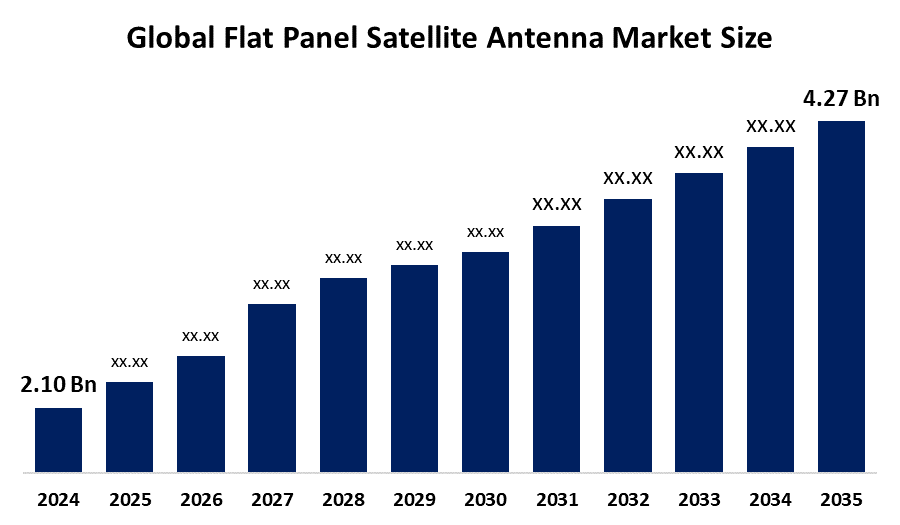
World’s Top 40 Companies in Flat Panel Satellite Antenna Market 2025 Watchlist: Statistical Report (2024–2035)
RELEASE DATE: Oct 2025 Author: Spherical InsightsRequest Free Sample Speak to Analyst
Description
According to a research report published by Spherical Insights & Consulting, The Global Flat Panel Satellite Antenna Market Size is projected To Grow from USD 2.10 Billion in 2024 to USD 4.27 Billion by 2035, at a CAGR of 6.66% during the forecast period 2025–2035. The market for Flat Panel Satellite Antenna is growing demand due to the growing need for dependable, fast connectivity in distant and mobile settings, the expanding usage of satellite communication technologies, the growing use of connected cars, and the growing use of these technologies in defense and aerospace applications.
Introduction
A Flat Panel Satellite Antenna Market Size is a small, low profile antenna device that transmits and receives satellite signals without the use of conventional parabolic dishes by using electronically or mechanically steered beamforming technologies. The growth of this sector can be attributed mainly to the increasing demand for compact and lightweight antennas, particularly for satellite and mobile communication applications. Moreover, the revolution of 5G technology, which demands better connectivity, is further pushing the utilization of flat panel antennas. The transition to smart technology, especially IoT devices, is also driving demand for flat panel antennas due to advances in both efficiency and coverage. Globally, demand has risen sharply with the advent of a type of low earth orbit satellite which are used for the detection of frequency in space communication systems. According to CARSURANCE in 2020, the world had roughly 35.02 million autonomous vehicles. The dataset noted an approximate increase of 3.62 million from 31.4 million autonomous vehicles in 2019.
Navigate Future Markets with Confidence: Insights from Spherical Insights LLP
The insights presented in this blog are derived from comprehensive market research conducted by Spherical Insights LLP, a trusted advisory partner to leading global enterprises. Backed by in-depth data analysis, expert forecasting, and industry-specific intelligence, our reports empower decision-makers to identify strategic growth opportunities in fast-evolving sectors. Clients seeking detailed market segmentation, competitive landscapes, regional outlooks, and future investment trends will find immense value in the full report. By leveraging our research, businesses can make informed decisions, gain a competitive edge, and stay ahead in the transition toward sustainable and profitable solutions.
Unlock exclusive market insights - Download the Brochure now and dive deeper into the future of the Flat Panel Satellite Antenna Market.
Flat Panel Satellite Antenna Market Size & Statistics
- The Market Size for Flat Panel Satellite Antenna Was estimated to be worth USD 2.10 Billion in 2024.
- The Market Size is going to Expand at a CAGR of 6.66% between 2025 and 2035.
- The Global Flat Panel Satellite Antenna Market Size is anticipated to reach USD 4.27 Billion by 2035.
- North America is expected to generate the highest demand during the forecast period in the Flat Panel Satellite Antenna Market
- Asia Pacific is expected to grow the fastest during the forecast period in the Flat Panel Satellite Antenna Market.

Regional growth and demand
Asia Pacific is expected to grow the fastest during the forecast period in the Flat Panel Satellite Antenna market.
Asia Pacific is expected to grow at a rapid CAGR, representing nearly 21.2% in the flat panel satellite antenna market during the forecast period. The Asia Pacific area has a thriving market for Flat Panel Satellite Antenna due to investments in broadband technology via satellite, the proliferation of connected devices, and the growing demand for high-speed Internet in rural and remote areas. Leading the way are China, Japan, South Korea, and India, leveraging satellite technology to aid in national security projects, smart cities, and digital infrastructure development. Countries in Southeast Asia are also developing as relevant growth markets influenced by the development of commercial aviation sectors and government initiatives for digital inclusion.
North America is expected to generate the highest demand during the forecast period in the Flat Panel Satellite Antenna market.
North America is anticipated to hold the largest share, representing nearly 38% of the flat panel satellite antenna market over the predicted timeframe. In the North America market, the market is rising due to the large investments in satellite communications infrastructure, a multitude of digital entrepreneurs, and the early adoption of LEO satellite services. The U.S. is leading the growth of the industry due to its significant demand from the commercial, aerospace, and defense sectors. Likewise, steady growth is also observed in Canada and Mexico, propelled by growing telecommunications networks and government efforts to bridge the digital divide.
Top 6 Trends in the Flat Panel Satellite Antenna Market
- Growth of Electronically Steered Antennas (ESAs)
- Expansion into LEO Constellations
- IoT and Automotive Applications
- Advancements in Beamforming and Signal Processing
- Cost Reduction Initiatives
- Increased Investment and Emerging Market Growth
1.Growth of Electronically Steered Antennas (ESAs)
The shift from mechanical to electronically steered antennas is a significant trend, enabling faster and dynamic beam steering without mechanical parts for enhanced performance and reliability.
2. Expansion into LEO Constellations
The proliferation of Low Earth Orbit (LEO) satellite constellations is driving demand for flat panel antennas to provide high-speed, low-latency, and broadband connectivity in remote areas.
3. IoT and Automotive Applications
Flat panel satellite antennas are increasingly integrated into the Internet of Things (IoT) devices and connected vehicles to meet data transfer and communication needs for various applications, notes Lucintel.
4. Advancements in Beamforming and Signal Processing
Innovations are improving antenna performance, leading to high-quality signals, reduced interference, and better bandwidth utilization.
Empower your strategic planning:
Stay informed with the latest industry insights and market trends to identify new opportunities and drive growth in the Flat Panel Satellite Antenna market. To explore more in-depth trends, insights, and forecasts, please refer to our detailed report.
Top 6 Companies Leading the Flat Panel Satellite Antenna Market
- Kymeta Corporation
- ThinKom Solutions
- Hanwha Phasor
- ALCAN Systems
- Ball Aerospace (BAE Systems)
- Gilat Satellite Networks
- Others
1. Kymeta corporation
Headquarters: U.S.
Kymeta Corporation is a leading developer of innovative, electronically steered, metamaterial-based flat-panel satellite antennas for mobile and stationary applications, serving defense, government, maritime, transport, and public safety sectors. They are known for their low-cost, low-power solutions that eliminate moving parts, integrate cellular and satellite networks, and provide ubiquitous broadband for on-the-move and stationary connectivity.
2. Thinkom Solutions
Headquarters: U.S.
ThinKom Solutions is a key player in the flat panel satellite antenna market, known for its innovative, ultra-low-profile, high-performance antennas, particularly for aviation. Their proprietary Variable Inclined Continuous Transmit and Receive (VICTS) phased-array technology enables seamless, high-speed connectivity across various satellite orbits (GSO and NGSO) and frequency bands (X, Ku, Ka, Q, and V), offering solutions for government, military, and mobile applications. ThinKom's antennas are designed for resilience, high spectral efficiency, and compliance with international regulations, positioning them as a strong competitor in the evolving, multi-constellation satellite landscape.
3. Hanwha Phasor
Headquarters: U.K.
Hanwha Phasor was a notable participant in the flat panel satellite antenna market, focusing on Active Electronically Steered Antennas (AESAs) for mobile, airborne, and military applications, before its assets were acquired by SWISSto12 in 2025 following voluntary liquidation. The company launched its Phasor L3300B land antenna for multi-orbit connectivity in 2024 and planned to partner with companies like OneWeb.
4. ALCAN Systems
Headquarters: Germany
ALCAN Systems plays a key role by developing and manufacturing innovative, ultra-thin, liquid crystal-based flat panel satellite antennas that offer low cost, low power, and no moving parts. By adapting display assembly line technology, ALCAN produces affordable and high-performance phased array antennas that provide electronically steered beams, enabling seamless connectivity for diverse markets including maritime, land mobility, enterprise, and 5G cellular backhaul.
Are you ready to discover more about the Flat Panel Satellite Antenna market?
The report provides an in-depth analysis of the leading companies operating in the global Flat Panel Satellite Antenna market. It includes a comparative assessment based on their product portfolios, business overviews, geographical footprint, strategic initiatives, market segment share, and SWOT analysis. Each company is profiled using a standardized format that includes:
Company Profiles
- Kymeta Corporation
- Business Overview
- Company Snapshot
- Products Overview
- Company Market Share Analysis
- Company Coverage Portfolio
- Financial Analysis
- Recent Developments
- Merger and Acquisitions
- SWOT Analysis
- ThinKom Solutions
- Hanwha Phasor
- ALCAN Systems
- Ball Aerospace (BAE Systems)
- Gilat Satellite Networks
- Others
Conclusion
The Flat Panel Satellite Antenna Market Size is poised for significant future expansion, driven by the global demand for compact, lightweight, and high-performance communication solutions. The industry's growth is fundamentally tied to major technological trends, particularly the shift toward Electronically Steered Antennas (ESAs) for enhanced reliability and performance, and the massive expansion into LEO satellite constellations to deliver high-speed, low-latency broadband to remote and mobile users. While North America is projected to maintain the largest market share due to substantial investments in satellite infrastructure and demand from the aerospace and defense sectors, the Asia Pacific region is anticipated to experience the fastest growth, fueled by government initiatives for digital inclusion, investments in broadband technology, and the development of smart cities. Overall, the market is characterized by a strong push to integrate these advanced antennas into IoT and automotive applications, leveraging innovations in beamforming and signal processing to meet the connectivity demands of a rapidly digitizing world.
Need help to buy this report?